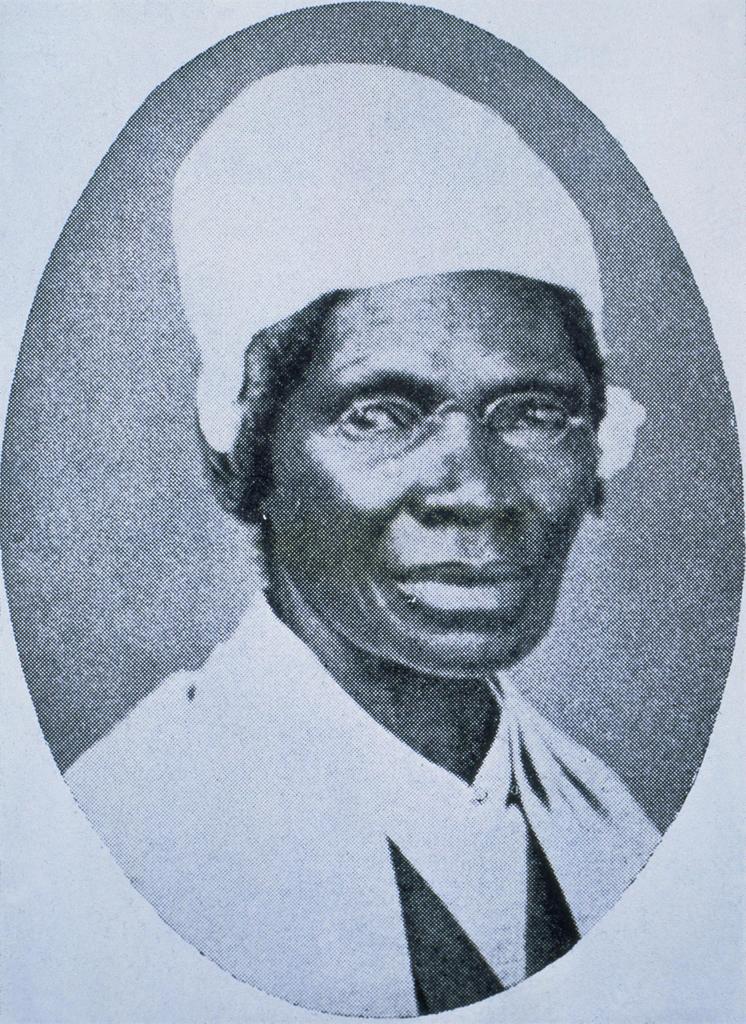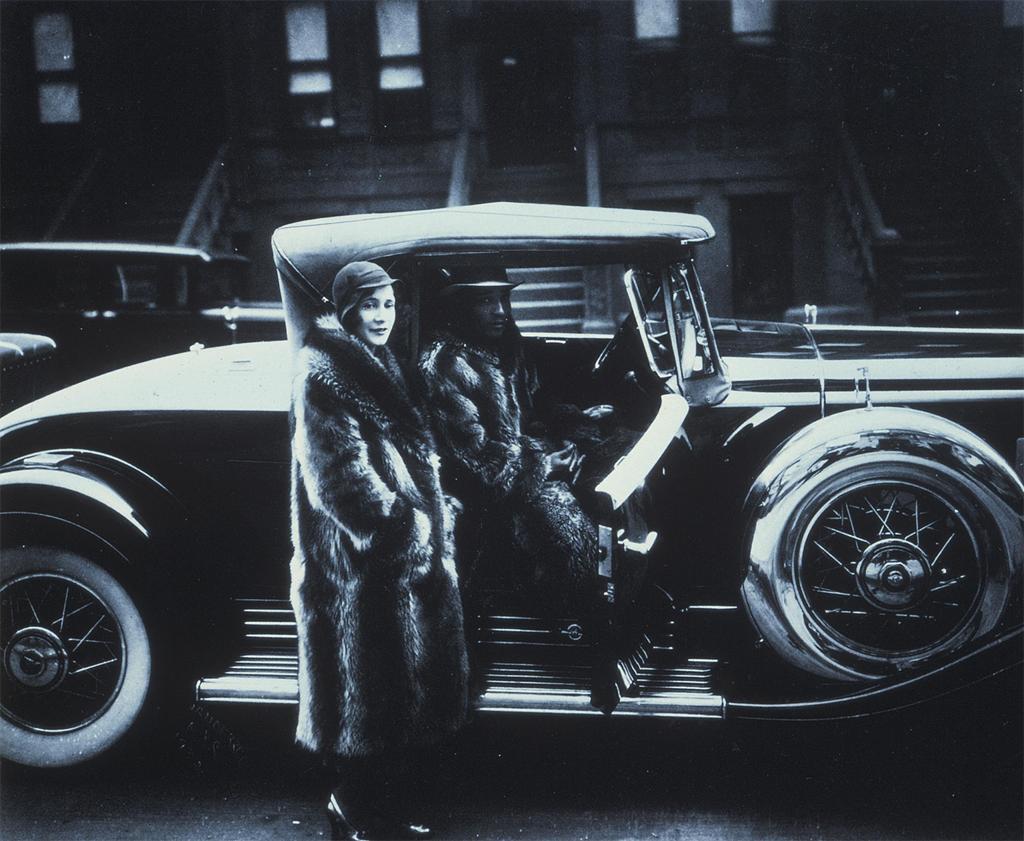The Beginnings of Slavery in America
The slave trade to British North America started in 1619, just twelve years after Jamestown, Virginia was first settled. Twenty slaves from the west coast of Africa were brought to the North American Mainland. By 1626, slaves were being shipped to New York City as well. (Horton, 27)
The Atlantic Slave trade was harsh. Disease, death, and inhumane conditions overwhelmed the African slaves as they boarded the boats. During the Middle Passage, the six to eight week journey across the Atlantic, many slaves tried to kill themselves or died due to the physical environment. The “cargo” was made to dance each day for exercise and to fight scurvy (it was believed at this time that scurvy was caused by a lack of exercise). Olaudah Equiano, an African captured from his hometown of Essaka, who later wrote eloquently and famously about his life as a slave, noted: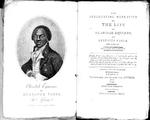 Olaudah Equiano,"The Interesting Narrative of Olaudah Equiano" 1794.
Olaudah Equiano,"The Interesting Narrative of Olaudah Equiano" 1794.
“The stench of the hold while we were on the coast was so intolerably loathsome, that it was dangerous to remain there for any time, and some of us had been permitted to stay on the deck for fresh air; but now that the whole ship’s cargo were confined together, in became absolutely pestilential. The closeness of place, the heat of the climate, added to the number in the ship, which was so crowded that each had scarcely room to turn himself, almost suffocated us…. The shrieks of the women, and the groans of the dying, rendered the whole scene of horror almost inconceivable… In this situation I expected every hour to share the fate of my companions, some of whom were almost daily brought upon deck at the point of death, which I began to hope would soon put an end to my miseries.” (Horton, 22)
In the colonial period, indentured white servants were also commonly used for cheap labor and had to serve a certain amount of time until they fulfilled the contractual agreement. While the white indentured servants usually came over on their own free will, the Africans were forcefully moved to America. Nevertheless, originally African slaves were treated like the indentured white servants once they had arrived in the colonies. For example, Anthony (Antonio) Johnson was an African who was able to gain his freedom and live without restraint after serving many years as a slave in Virginia. (Horton, 29) Although slaves initially had similar rights as the in "Atlantic Slave Trade" 1808.dentured servants, these rights were quickly removed and African slaves began to lose even the chance of freedom. (Kochlin, 11-12)
"Atlantic Slave Trade" 1808.dentured servants, these rights were quickly removed and African slaves began to lose even the chance of freedom. (Kochlin, 11-12)
Why did this happen? What changed the status of Africans from a forced indentured servant lifestyle to a slave without any rights? There are many answers to these questions worth exploring and all lead to the dependency on free and forced labor in America.
When the North American continent was first settled by Europeans, there were many problems with raising crops and most of the original settlers died due to disease and malnourishment. Out of the 900 original settlers of Jamestown in 1607, only 60 were alive by 1610. (WGBH, 33) This time was marked by desperate behavior, which even occasionally included cannibalism. According to John Smith’s General Historie of Virginia,
“Nay, so great was our famine, that a salvage we slew and buried, the poorer sort tooke him up againe and eat him; and so did divers one another boyled and stewed with roots and herbs: And one amongst the rest did kill his wife, powdered her, and had eaten part of her before it was knowne: for which hee was executed, as hee well deserved: now whether shee was better roasted, boyled, or carbonado’d, I know not but of such a dish as powdered wife I never heard of. This was that time, which still to this day we called the starving time.” (WGBH, 33)
Once it was discovered that that tobacco could grow well in the Virginian soil, settlers started to produce the crop and to sell it overseas in return for food and other goods. (WGBH, 33) Soon after, it was also discovered that rice grew well in the marshy conditions of the lower south (South Carolina and Georgia), and by 1770, 82 million pounds of rice were being exported overseas. (Kochlin, 25) To efficiently harvest the crops, cheap and free labor became an essential part of society, especially in the southern colonies.
By the late 1600s, few Englishmen were willing to become indentured servants, and along with a growing free white population in America, the economy required more and more slaver labor from Africa. By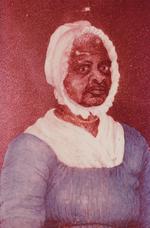 Susan Sedgewick, "Elizabeth Freeman (Mum Bett)" watercolor on ivory, 1811. 1661, slavery was recognized as a legal institution in Virginia, and soon the rest of the colonies followed. (Horton, 30)
Susan Sedgewick, "Elizabeth Freeman (Mum Bett)" watercolor on ivory, 1811. 1661, slavery was recognized as a legal institution in Virginia, and soon the rest of the colonies followed. (Horton, 30)
Skin color became an easy way for distinguishing between whites and black, thus slave from free person. It became a popular belief that blacks were meant to be slaves; it was “their natural state”. (Kochlin, 11) This belief would reappear a number of times throughout the subsequent centuries, especially during times of war.
Although slavery grew quickly in the United States some groups called for its abolishment early on. The Quakers of Germantown, Pennsylvania were the first to protest slavery in 1688 and in 1773 banned any member of their church from having slaves. Four years later, Vermont would ban slavery and many more of the northern states would follow, including Massachusetts when Elizabeth Freeman (Mum Betts) sued the state for violating her constitutional rights. The Supreme Court agreed and set a precedent saying the slavery was incompatible with the state constitution. (Horton, 66)
Several new legal standings began to emerge and set a precedent for future laws that would take away the rights of Africans and African Americans over the next several centuries. Blacks and whites were not allowed to marry, slaves could not gather without a white supervisor, blacks could not testify in court, and many more absurd regulations that repressed blacks would be put into state laws. (Horton, 38) Often times, these laws were passed in retaliation after a slave rebellion.
The Stono River Rebellion is a prime example of such a situation: on September 9, 1739 one of the most deadly of all slave revolts the in British colonies began. Jemmy, an Angolan born slave, along with both Africans and American born slaves, marched toward Stono Bridge in Charleston. They were attempting to get to Florida, where the Spanish had promised freedom to the enslaved. Once arriving at Stono River, the rebels killed storeowners and slave owning families, but spared the lives of those who treated their slaves well. While on their march, they set other slaves free and welcomed them to join the search for freedom. By the end of the day, over 60 slaves had joined the group and twenty whites had been killed. (WGBH, 95-106) The slaves were eventually captured and executed for their rebellion against the system.
Because of the Stono River Rebellion, lawmakers in South Carolina in a 1740 banned “freedom of movement, communal gatherings, and learning to write” amongst blacks in a slave code. (WGBH, 106) This rebellion struck so much fear in whites, they believed the only way to avoid such an event again would be to “unconditionally control” the slave population. At the same time, other laws seemed to be aimed at improving the conditions of slaves, such as reduced hours on Sundays. However, this was more of a ploy slave loyalty than a result of genuine concern for their work conditions. (WGBH, 106)
Although there is not much artwork surviving until today from this time period, freed and enslaved African Americans were actively involved in the creation of objects, drawings, and other forms of artistic expression. Many had skills in carpentry, metal work, pottery, and sewing. (Patton, 34)
Many whites thought that because the voyage from Africa to America was so brutal, the Africans’ memory of their home would be erased and thus they were like a blank slate when they arrived. Although it may seem obvious today that is would be untrue, the folk art produced during this time gives evidence that this myth is false (Patton, 24).
Slaves created many objects, like drums, to use in cultural practices and rituals. Although drums from around 1645 have been found, it is known that many slave owners prohibited their use because they sounded much like African speech and the slave owners were scared that it could start a revolt. These drums, while taking on the look of traditional African instruments, had to change due to new conditions such as different wood types. Although this might seem to be trivial the changes seen in the beginning would become larger 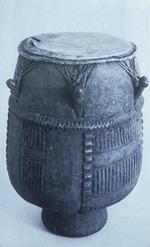 "Asante Style Drum" wood, vegetable fibre, deerskin, early 18th century.as the years pass. Cultural influence as well can be seen in later folk art (Patton, 37).
"Asante Style Drum" wood, vegetable fibre, deerskin, early 18th century.as the years pass. Cultural influence as well can be seen in later folk art (Patton, 37).
Metalworking was also traditional African trade and although used still for cultural and social reasons would make a slave more valuable. Many slave communities around Mali knew how to work iron because of ritual practices, and those who were particularly skilled were considered to be a political and spiritual authority amongst others from that region. Statues found in Virginia take on many of the same characteristics as those found in Mali, suggesting that not only was traditional African culture brought to America, but was still used in everyday life. (Patton, 37)
Pottery has further demonstrated the transfer and adaptation of African traditions in the western world. This pottery shows many of the traditional African methods and styles, but it also shows how European and American Indian styles were beginning to infiltrate African culture. This convergence of styles depended greatly on the amount of contact that the slaves had with the white community and the American Indian community. (Patton, 39) 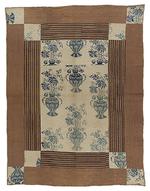 "Pieced Quilt" textiles, late 18th century.
"Pieced Quilt" textiles, late 18th century.
Quilting was another popular form of art during this time but little has been recovered. This type of folk art would become a tool to tell narratives, give directions to safe houses for the Underground Railroad, and depict stories of the bible. Quilting also became a way for black women to socialize and quilting bees and other group quilting parties became a part of life amongst African American women in the 19th century. (Patton, 67)
The origins of slavery in the British North American colonies set a precedent for the future on how blacks and other non-whites should be treated in the 19th and 20th centuries in the United States.


